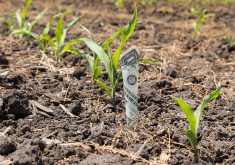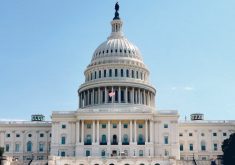As difficult as it was for Republicans in the U.S. House of Representatives to find an electable leader, that rough start was the easy part. Ahead lies governing, and it promises to be tricky.
First up is Congress’s need to act by mid-November to either keep the government open or shut it down. It’s the House’s move; the Senate appears willing to approve any reasonable plan that keeps the gears of government grinding.
What will the House do? So far, the tea leaves suggest more chaos.
Read Also

Invigor Gold variety viewed as threat to condiment mustard
Invigor Gold, the canola-quality mustard developed by BASF, is on a collision course with Canada’s condiment mustard industry. It’s difficult to see how the two can co-exist.
Newly anointed speaker, Mike Johnson of Louisiana, a case-hardened conservative by all accounts, wants one-for-one budget offsets from President Joe Biden’s cherished Inflation Reduction Act before presenting any House resolution to spend anything on any program.
It’s a legislative throwdown that will test Johnson’s willingness to use the ultimate weapon — a federal government shutdown that impacts millions of Americans — to score a political point by embarrassing congressional Democrats and the White House.
This isn’t a parlour game; it carries an enormous risk. Recent past shutdowns, all pushed by House Republicans, quickly turned into political mud that stuck to them in every subsequent election. As such, spending shutdowns carry a long-term election cost for the shutdown party that far outweighs any short-term political gain.
Second, the initial “you-give-us-offsets/we-give-you-funding” formula will get a trial run as Johnson proposes a similar offer for a $106 billion aid package the White House — and most of Congress — wants for Israel, Ukraine and U.S. border programs.
This should interest farmers and ranchers because several Republican members of the House and Senate agriculture committees propose a similar “raid” on “climate funding and some rural development accounts,” the Food & Environmental Reporting Network said Oct. 29, “to offset the cost of raising reference prices, which would make it easier to trigger crop subsidy payments.”
In short, urge these agricultural Republicans, Congress should take already budgeted, long-term ag money — principally parts of the IRA’s “green ag” cash, food aid money from the Supplement Nutrition Assistance Program (SNAP) and conservation funds — to increase today’s farm program subsidies to mainly corn, cotton, soybean, wheat, rice and peanut growers.
But this isn’t the old rob-Peter-to-pay-Paul scheme. It’s a bald-faced hustle that grabs most of Peter’s future mortgage money to buy Paul candy today.
Don’t take my word for it; University of Illinois farm policy expert and former U.S. Department of Agriculture official Jonathan Coppess criticized the idea in an Oct. 26 post on farmdocDAILY.
“The politics of doing so are perilous at best,” Coppess said, considering “that efforts to cut SNAP nearly derailed both the 2014 and 2018 farm bills… The reported proposal, if pursued, would be worse than either of those … fights (because it) would pit farmers against rural communities and against low-income Americans.”
Imagine the headlines: “Farmers take food out of the mouths of America’s hungry, rural and poor.” There goes the rural/urban SNAP coalition.
Additionally, Coppess said, the plan “also pit(s) … farmers seeking conservation funding against those who might receive additional farm program payments.”
There goes the Hook-and-Bullet Gang and the green lobby.
Then there’s the proposed higher reference prices, which Coppess said are a “gamble on whether Congress can pick the right prices to write into the statute.”
All those in favour of Congress “picking the right prices” for the upcoming farm bill, raise your right hand.
In short, as badly as the 2018 law needs updating to reflect an ever-changing market and the fast-changing climate, the Republicans’ “controversial proposal to reduce conservation, SNAP and rural development funding by $50 billion” to boost program payments screams that a farm bill “extension is the least bad option” right now, Coppess said.
Moreover, adds the past administrator of the Farm Service Agency, “It may even be worth considering a continuation of the current farm program for another five years rather than gamble away the farm bill coalition.”
In short, keep today’s House chaos away from tomorrow’s farm bill.
Alan Guebert is an agricultural commentator from Illinois.







![As often is the case with House Republicans, however, the new leader’s hardest job won’t be any of [the] tough, all but intractable problems. The harder, more perilous task will be finding a safe path through GOP minefields to get to the other side of the political divide to even negotiate. | File photo](https://static.producer.com/wp-content/uploads/2023/10/25161633/10-Washington-DC-Capitol-bldg-235x165.jpg)









